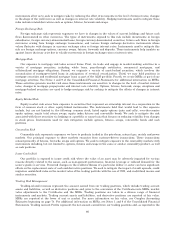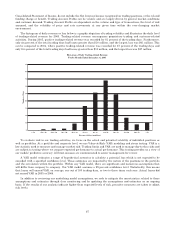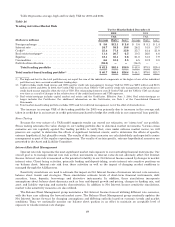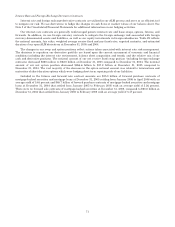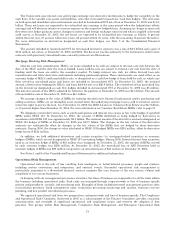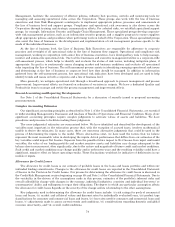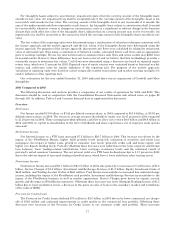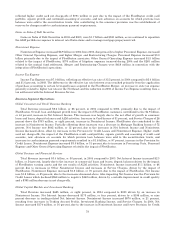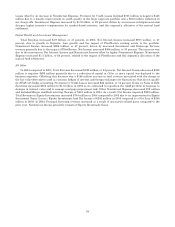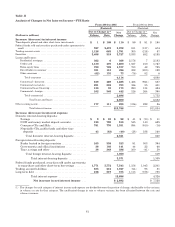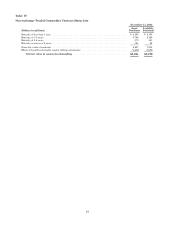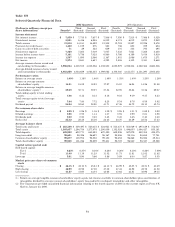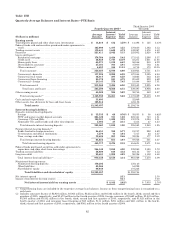Bank of America 2005 Annual Report Download - page 112
Download and view the complete annual report
Please find page 112 of the 2005 Bank of America annual report below. You can navigate through the pages in the report by either clicking on the pages listed below, or by using the keyword search tool below to find specific information within the annual report.The Corporation recognizes gains and losses at inception of a derivative contract only if the fair value of the contract
is evidenced by a quoted market price in an active market, an observable price or other market transaction, or other
observable data supporting a valuation model.For those gains and losses not evidenced by the above mentioned market
data, the transaction price is used as the fair value of the derivative contract. Any difference between the transaction
price and the model fair value is considered an unrecognized gain or loss at inception of the contract. Previously
unrecognized gains and losses are recorded in income using the straight line method of amortization over the contractual
life of the derivative contract. Earlier recognition of the full unrecognized gain or loss is permitted if the trade is
terminated early, subsequent market activity is observed which supports the model fair value of the contract, or
significant inputs used in the valuation model become observable.
AFS Securities are recorded at fair value, which is generally based on direct market quotes from actively traded
markets.
Principal Investing
Principal Investing is included within Equity Investments and is discussed in more detail in Business Segment
Operations beginning on page 26. Principal Investing is comprised of a diversified portfolio of investments in privately-
held and publicly-traded companies at all stages, from start-up to buyout. These investments are made either directly in
a company or held through a fund. Some of these companies may need access to additional cash to support their long-
term business models. Market conditions and company performance may impact whether funding is available from
private investors or the capital markets.
Investments with active market quotes are carried at estimated fair value; however, the majority of our investments
do not have publicly available price quotations. At December 31, 2005, we had nonpublic investments of $6.1 billion or
approximately 95 percent of the total portfolio. Valuation of these investments requires significant management
judgment. Management determines values of the underlying investments based on multiple methodologies including
in-depth semi-annual reviews of the investee’s financial statements and financial condition, discounted cash flows, the
prospects of the investee’s industry and current overall market conditions for similar investments. In addition, on a
quarterly basis as events occur or information comes to the attention of management that indicates a change in the
value of an investment is warranted, investments are adjusted from their original invested amount to estimated fair
values at the balance sheet date with changes being recorded in Equity Investment Gains in the Consolidated Statement
of Income. Investments are not adjusted above the original amount invested unless there is clear evidence of a fair value
in excess of the original invested amount. This evidence is often in the form of a recent transaction in the investment. As
part of the valuation process, senior management reviews the portfolio and determines when an impairment needs to be
recorded. The Principal Investing portfolio is not material to our Consolidated Balance Sheet, but the impact of the
valuation adjustments may be material to our operating results for any particular quarter.
Accrued Income Taxes
As more fully described in Notes 1 and 18 of the Consolidated Financial Statements, we account for income taxes in
accordance with SFAS No. 109, “Accounting for Income Taxes” (SFAS 109). Accrued income taxes, reported as a
component of Accrued Expenses and Other Liabilities on our Consolidated Balance Sheet, represents the net amount of
current income taxes we expect to pay to or receive from various taxing jurisdictions attributable to our operations to
date. We currently file income tax returns in more than 100 jurisdictions and consider many factors—including
statutory, judicial and regulatory guidance—in estimating the appropriate accrued income taxes for each jurisdiction.
In applying the principles of SFAS 109, we monitor relevant tax authorities and change our estimate of accrued
income taxes due to changes in income tax laws and their interpretation by the courts and regulatory authorities. These
revisions of our estimate of accrued income taxes, which also may result from our own income tax planning and from the
resolution of income tax controversies, can materially affect our operating results for any given quarter.
Goodwill and Other Intangibles
The nature of and accounting for Goodwill and Other Intangibles is discussed in detail in Notes 1 and 10 of the
Consolidated Financial Statements. Goodwill is reviewed for potential impairment at the reporting unit level on an
annual basis, or in interim periods if events or circumstances indicate a potential impairment. The reporting units
utilized for this test were those that are one level below the business segments identified on page 26. The impairment
test is performed in two steps. The first step of the Goodwill impairment test compares the fair value of the reporting
unit with its carrying amount, including Goodwill. If the fair value of the reporting unit exceeds its carrying amount,
Goodwill of the reporting unit is considered not impaired; however, if the carrying amount of the reporting unit exceeds
its fair value, the second step must be performed. The second step compares the implied fair value of the reporting unit’s
Goodwill, as defined in SFAS No. 142, “Goodwill and Other Intangible Assets” (SFAS 142), with the carrying amount of
that Goodwill. An impairment loss is recorded to the extent that the carrying amount of Goodwill exceeds its implied fair
value.
76


